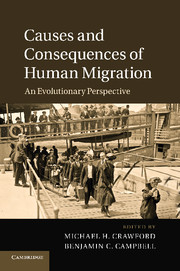1 - Perspectives on human migration: introduction
Published online by Cambridge University Press: 05 December 2012
Summary
Introduction
Migration has a deep history, dating back to the very origins of our species. An evolutionary perspective suggests that an activity as deeply rooted and ubiquitous as migration must be imbedded in our human nature and genes. Thus, the social and cultural factors involved in migration are intertwined within our human biology. Not only are ecological factors such as climate important in the economic push/pull factors that social scientists consider to underlie decisions about migration, but there may be individual variation in our genomes that lead to a propensity to migrating in the first place (see the chapter by Ben Campbell and Lindsay Barone on the variation in dopamine receptors and its association with migration out of Africa).
Furthermore, far from being simply the bearer of ideas and institutions, as sociologists might have it, or job skills and economic goods as the economists may emphasize, migrants represent bodies that carry an imprint of their original surroundings. These include the transmission of disease vectors as well as physiological and behavioral traits that can influence chronic diseases, especially metabolic conditions associated with eating and activity and mental illness (see the chapter by M. J. Mosher on potential epigenetic effects associated with dietary changes in migrant populations). These imprints also include more behavioral and evolutionary factors such as fertility and fecundity patterns that have important demographic consequences in the migrant’s new home.
- Type
- Chapter
- Information
- Causes and Consequences of Human MigrationAn Evolutionary Perspective, pp. 1 - 8Publisher: Cambridge University PressPrint publication year: 2012
References
- 1
- Cited by

